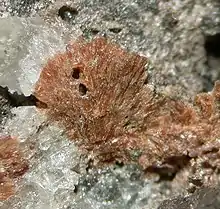Cabalzarite
Cabalzarite is a rare arsenate mineral with the chemical formula Ca(Mg,Al,Fe3+
)
2[AsO
4]
2•2(H
2O,OH). It is a member of the tsumcorite group. It crystallizes in the monoclinic system and typically occurs as clusters of crystals or granular aggregates.[1][2]
| Cabalzarite | |
|---|---|
 Cabalzarite found in Switzerland | |
| General | |
| Category | Arsenate minerals |
| Formula (repeating unit) | Ca(Mg,Al,Fe3+ ) 2[AsO 4] 2•2(H 2O,OH) |
| Strunz classification | 8.CG.15 |
| Crystal system | Monoclinic |
| Crystal class | Prismatic (2/m) (same H-M symbol) |
| Space group | C2/m |
| Unit cell | a = 8.925 Å, b = 6.143 Å, c = 7.352 Å, β = 115.25°; Z = 2 |
| Identification | |
| Color | Light brown, brownish pink, orange brown |
| Crystal habit | Aggregates and clusters, granular |
| Fracture | Irregular |
| Mohs scale hardness | 5 |
| Luster | Vitreous |
| Streak | White |
| Diaphaneity | transparent |
| Specific gravity | 3.89 |
| Optical properties | Biaxial |
| Refractive index | nα = 1.700 nγ = 1.760 |
| Birefringence | δ = 0.060 |
| References | [1][2][3] |
It was first described for samples from an abandoned manganese mine in Falotta, Graubünden, Switzerland and named for Swiss amateur mineralogist Walter Cabalzar. It was approved as a new mineral by the IMA in 1997. It has also been reported from the Aghbar mine in Ouarzazate Province, Morocco.[2]
References
- Cabalzarite mineral data from Webmineral
- Cabalzarite mineral information on Mindat.org
- Brugger J., Meisser N., Schenk K., Berlepsch P., Bonin M., Armbruster T., Nyfeler D. and Schmidt S. 2000: Description and crystal structure of cabalzarite Ca(Mg,Fe,Al)2(AsO4)2(H2O,OH)2, a new mineral from the tsumcorite group. American Mineralogist, 85(9), 1307-1314;
| Wikimedia Commons has media related to Cabalzarite. |
This article is issued from Wikipedia. The text is licensed under Creative Commons - Attribution - Sharealike. Additional terms may apply for the media files.